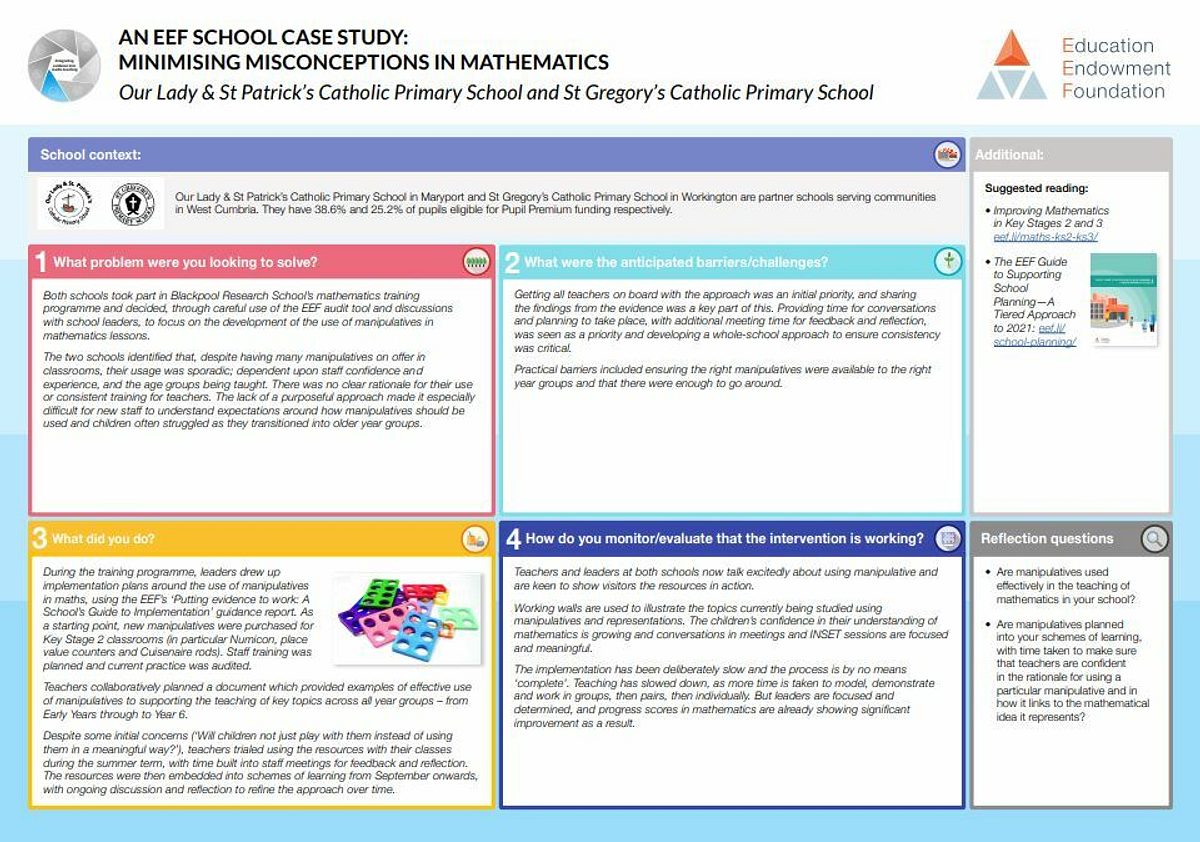What are your existing beliefs and assumptions about using manipulatives?
- Are manipulatives more useful for younger children, or should they be used throughout school and beyond?
- Should we discourage the use of manipulatives where possible, with an eye towards external examinations where they cannot usually be used?
- Does it matter which manipulatives are used for which mathematical concepts or ideas?

If all teachers of mathematics in your school were asked these questions, would there be broad agreement in their answers?
Manipulatives can be powerful tools for supporting pupils to engage with mathematical ideas. However, they are just tools, and need to be used purposefully and appropriately in order to have an impact.
Given the importance of the use of manipulatives in mathematics teaching, it is useful to consider the evidence around their use in classrooms. Our guidance report, based on an extensive review of the evidence on teaching KS2 and 3 mathematics, found that:
- Manipulatives can help pupils engage with mathematical ideas, but are just tools – consideration of how they are used is essential.
- There should be a clear rationale for using a particular manipulative to teach a specific mathematical concept.
- Pupils should be enabled to understand the links between the manipulatives and the mathematical ideas they represent.
- Manipulatives should be temporary, acting as a scaffold that can be removed once independence is achieved.
- Manipulatives can be used to support pupils of all ages – they should be removed in response to knowledge and understanding rather than age.
So, what might this look like in the classroom?
Our Lady and St Patrick’s is a Primary school in Maryport, situated on the windswept west coast of Cumbria. Together with their partner school, St Gregory’s in Workington, they took part in a Research School Network mathematics training programme and decided, through careful use of the EEF audit tool and discussions with school leaders, to focus on developing of the use of manipulatives in mathematics lessons.
The two schools identified that, despite having many manipulatives on offer in classrooms, their usage was sporadic; dependent upon staff confidence, experience and age group taught. There was not always a clear rationale for their use or consistent training for teachers, making it especially difficult for new staff. This also meant that transition through the year groups sometimes left children confused and struggling.
During the training programme leaders drew up implementation plans, using the EEF’s implementation guidance report as a starting point, a process which continued when they returned to school. New manipulatives were purchased for Key Stage 2 classrooms (in particular Numicon, place value counters and Cuisenaire rods), staff training was planned and current practices were audited
Teachers were a key part of this process, and they collaboratively developed a document detailing examples of the use of manipulatives in supporting the teaching of key topics across all year groups – from Early Years to Year 6. Despite some concerns (‘Will children not just play with them instead of using them in a meaningful way?’), teachers trialled the resources during the summer term, with time built into meetings for feedback and reflection.
Teachers and leaders at both schools now talk excitedly about manipulative use and are keen to show visitors the resources in action. Working walls are used to illustrate the topics currently being studied using manipulatives and representations, children are growing in confidence in their understanding of mathematics and conversations in meetings and INSET sessions are focused and meaningful
The implementation has been deliberately slow and the process is by no means ‘complete’, with more time also being taken to model, demonstrate and work in groups, then pairs, then individually. But leaders are focused and determined, and progress scores in mathematics are already showing improvement as a result.

Tips from the schools’ experiences
- Hold your nerve – this might not be a ‘quick win’ – and will require investment in time and resources.
- Consider: what’s your rationale? Why have you chosen to use a particular manipulative for a particular topic or idea? Is it supporting an identified area of need for your children and school?
- Provide time. This will be needed for initial planning and discussions but should also be factored in moving forward for follow-up meetings and sharing of experiences.
- Have an exit strategy – consider at the start how you are going to move children away from using a manipulative, perhaps towards using a representation. Remember – this doesn’t have to be done quickly!
Five ‘big questions’ for discussion
- Is consideration of how, why and when manipulatives are used at the forefront of your planning?
- Are pupils supported to understand the links between the manipulatives and the mathematical ideas they represent?
- Is time given to teachers to discuss the use of manipulatives, to share ideas and experiences from the classroom?
- Do you consider an ‘exit strategy’ to support pupils in moving away from using a manipulative when they are ready to do so?
- Are you using manipulatives with pupils of all ages?
